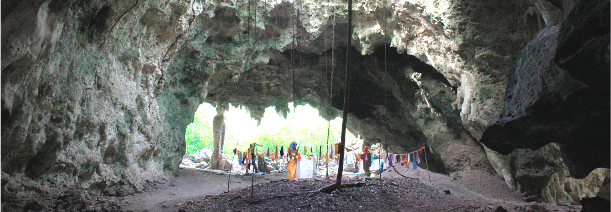New Excavations in Kuumbi Cave

New Excavations in Kuumbi Cave, Zanzibar
August 17, 2016
A multidisciplinary team of scientists recently excavated one of Zanzibar’s most important caves, revealing a complex human occupation history over the last 18,000 years. Initial occupations by Later Stone Age hunter-gatherers ranged between ~18,000 – 13,000 years ago. Later peoples inhabited the cave in the late first to early second millennia AD. The new research contrasts with previous excavations and interpretations, painting a radically different picture of human habitation in the Zanzibar Archipelago of Tanzania.
Kuumbi Cave is well known in East African prehistory thanks to excavations by investigators since 2005. Previous work controversially suggested that Middle Stone Age groups occupied the cave at ~26,000 years ago followed by occupations by coastal Neolithic people who had already incorporated the domesticates, such as the chicken, into their diet. New excavations by an international group of multidisciplinary researchers, led by Dr Nicole Boivin, Director of the Department of Archaeology, Max Planck, Jena, has revised what we know about this important cave site.
A series of new chronometric ages and reassessment of the stratigraphy indicated three main phases of human occupation. Two phases occurred in the Later Stone age by mobile foragers, indicated by quartz microlithic toolkits, bone points and the exploitation and use of terrestrial fauna, land snails, shellfish and marine fish. The first Later Stone Age occupation of the site corresponds with a thick and dense layer of snail shells, though it is not clear if this is a natural death assemblage or the consequence of human subsistence, though some evidence hints at predation by foragers.
A later occupation occurred at Kuumbi Cave at ca. 600 AD by Iron Age groups using local styles of Tana or Triangular Incised Ware ceramics, stone tools and shell beads. The diet of these later groups incorporated marine resources and smaller terrestrial animals, similar to Later Stone age subsistence practices, though a few larger animals were present, such as Zebra. The Iron Age occupations contrasted somewhat with earlier occupations in showing an increased reliance on fish, particularly reef species.
The new excavations indicate that Kuumbi Cave was not occupied for long periods of time, including in the Holocene when sea levels rose steadily, cutting Zanzibar off from the mainland, and leading to the formation of the present island. New investigations in Kuumbi do not support previous archaeological findings and interpretations, as the cave had no evidence of a Middle Stone Age and Neolithic occupations, nor Asian domesticates such as the chicken. Further field work is needed, Dr. Boivin noting, “No doubt future archaeological field work across East Africa will help to understand cultural practices of East African peoples through time.”
Shipton, C, et al., Reinvestigation of Kuumbi Cave, Zanzibar, reveals Later Stone Age coastal habitation, early Holocene abandonment and Iron Age reoccupation. Azania 51 (2), S. 197-233 (2016).
http://www.tandfonline.com/doi/full/10.1080/0067270X.2016.1173308
Information:
Dr. Nicole L. Boivin
boivin@shh.mpg.de
Nicole Boivin is the Director of the Department of Archaeology at the Max Planck Institute for the Science of Human History
Photo:
Kuumbi Cave, interior of the site looking outwards.
Credit: http://www.tandfonline.com/doi/full/10.1080/0067270X.2016.1173308
Photo:
Shell beads from the Iron Age levels at Kuumbi Cave
Credit:
http://www.tandfonline.com/doi/full/10.1080/0067270X.2016.1173308





